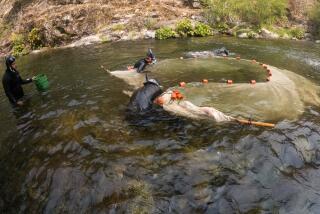Klamath’s Water Is Better Used Downriver, Study Finds
- Share via
Higher water flows in the Klamath River along with increased salmon runs could generate billions more dollars than is currently made from irrigated cropland, according to a new federal study.
The study by an economist with the U.S. Geological Survey maintains that the recreational benefits of higher flows would be felt mainly at the lower end of the river. The Klamath begins along the California-Oregon border and flows 250 miles southwest to the Pacific.
The USGS study, released last week, looks at the economic consequences of changing a policy on the way water is distributed from the river. Under the Bush administration, that policy has favored farming interests in the Klamath basin at the upper end of the river.
The study echoes provisions of a bill introduced Oct. 24 by Rep. Mike Thompson (D-St. Helena) that seeks $200 million to buy farmland in the Klamath basin, boost river flows and improve water quality.
For 18 months, a bitter battle for water in the Klamath River watershed has pitted farmers against environmentalists and fishermen. The conflict intensified this fall after 33,000 salmon died in the lower river.
A U.S. Fish and Wildlife Service report on the cause of the die-off is due, at the earliest, early next year, but state officials and other interested parties believe the culprit was low flows due to agricultural diversions ordered by the U.S. Bureau of Reclamation in May.
The goal of the economic report by government economist Aaron Douglas was to compare the costs and benefits of leaving more water in the river versus current policy.
Douglas found that recreation on the lower Klamath, including sportfishing and rafting, currently brings in $800 million each year, compared with $100 million in farm revenues in the Klamath Basin. The farms there, covering about 240,000 acres, are the largest user of Klamath River water.
Although the Klamath basin itself would not benefit from the down-river recreation, the study assumes that all the farmland in the basin would be purchased and the farmers compensated handsomely. The price tag for that and for restoring the entire Klamath watershed would be nearly $5 billion.
Douglas said the economic benefits of such an ambitious project would easily pay all the associated costs, including buying and retiring some commercial fishing rights.
Douglas determined that if all the proposed improvements were made, the river would bring in $300,000 more in tourism money each year. In addition, Douglas estimated, the benefits from investing $5 billion in restoration would exceed $40 billion.
Economists have for years tried to calculate the worth of healthy environments. Many conservation groups believe that eco-tourism, in particular, will bring more steady money to a region than activities subject to boom-and-bust cycles such as logging, ranching and farming.
But other proposals to save water by fallowing farmland have proved enormously controversial because of the effect on agricultural employment and on the businesses that depend on the farm economy. Such is the case in the Imperial Valley in Southern California, where residents are fiercely debating a plan to fallow fields and transfer irrigation water to urban users in San Diego.
More to Read
Sign up for Essential California
The most important California stories and recommendations in your inbox every morning.
You may occasionally receive promotional content from the Los Angeles Times.













